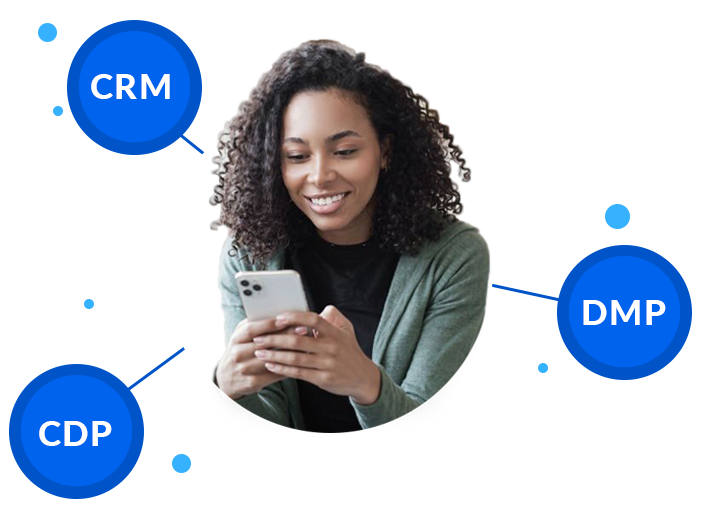In today’s digital age, the significance of data cannot be overstated. For businesses, the ability to collect and analyze customer data is not only crucial but also transformative. This invaluable asset enables companies to enhance their understanding of their customers and tailor strategies and offerings in response to evolving needs and preferences. In an era defined by data-driven decision-making, harnessing the power of information is not merely advantageous; it’s imperative for maintaining competitiveness and agility in the market. Consequently, many companies employ specialized tools to effectively gather and analyze customer data.
However, selecting the right data platform can be a daunting task, with options like CRM, CDP, and DMP to consider. A wrong choice can have far-reaching consequences, impacting the effectiveness of your entire marketing and sales strategy. Therefore, it’s essential to identify the most suitable platform and master its efficient utilization. Among these three platforms, CDPs gather data related to customer interactions with your product or service. CRMs primarily center on customer interactions with your team. In contrast, DMPs primarily aim to extract data from second and third-party sources.
Let’s begin by understanding each of these platforms before diving deeper into each platform:
Customer Data Platforms (CDPs)
CDPs are specialized tools designed for marketers. They collect first-party data from various sources to comprehensively view each customer. Marketers leverage CDP data to craft personalized marketing campaigns. CDPs unify data across channels, enabling the creation of customer profiles and personalized experiences based on known and unknown behaviors.
CDPs consolidate a company’s diverse customer data sources into a unified repository. This entails linking various customer interactions to create a single customer identity, transcending data silos across marketing clouds, service software, and e-commerce platforms—a process referred to as customer resolution.
Subsequently, CDPs tackle the challenge of reconciling customer identities and aligning known customer identifiers like email addresses and mobile numbers with anonymous data such as cookies and mobile device IDs. This enables the seamless association of a customer’s journey, starting from an email campaign and extending to website interactions, under one coherent identity—commonly known as cross-device identity.
Once CDPs establish these unified customer profiles, they facilitate real-time data accessibility, allowing companies to deliver personalized experiences. This involves integrating customer data with a multitude of systems, including email-send engines, demand-side platforms, and content management systems.
Business applications can seamlessly utilize standardized data from the CDP to streamline various operations, such as segmentation, web personalization, journey optimization, marketing campaigns, determining next best actions, suggesting products/services, identifying churn, conducting sentiment analysis, and resolving cases.
Customer Data Platforms (CDPs) are the game-changers as they empower businesses to unlock their full potential in these domains. Personalization is the cornerstone of effective digital marketing, and CDPs excel in this regard. By utilizing both identity data (such as names) and behavioral data (like topics of interest), CDPs enable businesses to deliver highly customized content to their audience. Gone are the days of one-size-fits-all marketing; with CDPs, every interaction feels uniquely tailored to the individual. Segmentation is another powerful tool in the CDP arsenal. By segmenting customers based on transactional data, businesses can engage with their audience through the channels they prefer and use. This level of precision enables automated communication, timely messaging, and offers that align perfectly with each customer’s needs and capabilities.
How Does a CDP Work?
CDPs Offer a Range of Advantages that Significantly Impact Business Success:
Unified Ideal Customer Profiles: CDPs serve as a centralized repository for all customer data, irrespective of the source. This consolidation simplifies the process of creating ideal customer profiles (ICPs). With data from various campaign sources such as social media, email, or search collected in one place, businesses can achieve two critical goals:
1. Attain a more profound insight into the distinctive journey of every customer.
2. Develop highly effective strategies to engage and target these customers.
In an era where companies interact with customers through multiple touchpoints, relying on numerous platforms to collect and analyze data can be counterproductive and perplexing. CDPs emerge as a more efficient and cohesive solution.
Increased Personalization: Personalization is a key driver of customer satisfaction and loyalty. CDPs leverage the abundance of data they store to unlock new realms of personalization opportunities. For marketers, catering to individual preferences is crucial even as studies show that 60 per cent of customers are inclined to become repeat buyers following a personalized shopping experience. Many businesses struggle with personalization due to limited customer data, making CDPs a valuable solution to this challenge.
Increased Revenue: CDPs are pivotal in boosting customer satisfaction and enabling intelligent targeting, resulting in higher revenue generation. Businesses gain a holistic view of each customer by aggregating data from various sources. This comprehensive understanding allows for the customization of offers and messaging to align with individual preferences.
Data Management Platforms (DMPs)
DMPs collect and organize data from first, second, and third-party sources, encompassing online, offline, and mobile data, including demographics, browsing behavior, location, and device information. DMPs empower businesses to segment customers for personalized offerings effectively.
DMPs offer Several Advantages that Streamline Marketing Efforts and Enhance data Utilization:
Streamlined Data: In today’s complex digital landscape, marketers often find themselves juggling a multitude of tools and platforms. DMPs play a crucial role in simplifying this process. They enable you to aggregate data from various sources and create coherent audience segments. This consolidation ensures that your campaigns and strategic decisions are built upon consistent and unified data, resulting in more effective marketing efforts.
Access to Second and Third-Party Data: DMPs stand out by collecting and integrating data from first-party sources and reputable second and third-party sources. This capability is a significant advantage, especially when you require additional insights to enhance your customer personas. DMPs provide access to external data sources that align with your customer profile, enriching your understanding of your audience and enabling more targeted marketing strategies.
Efficient Budget Management: DMPs contribute to more efficient budget management in advertising. They eliminate the need to run multiple ads simultaneously to increase the chances of reaching the right audience. Instead, DMPs facilitate retargeting efforts, allowing you to focus your resources on specific groups. For example, you can retarget prospects who have visited your “pricing” page or reconnect with past customers. This precision in targeting reduces advertising spending and enhances the effectiveness of your marketing campaigns, ultimately optimizing your budget allocation.
Customer Relationship Management (CRM)
Customer relationship management (CRM) platforms monitor and oversee interactions with customers and potential clients across their entire journey. CRMs yield favorable outcomes by enhancing business relationships, leading to the company’s expansion. Customer relationship management software is a valuable tool for sales, marketing, and customer success teams. Its purpose is to enhance customer relationships and, by extension, Customer Lifetime Value (CLV). This holds immense significance due to the daily volume of data businesses generate. The challenge of handling customer data underscores the importance of CRM systems.
CRMs Offer Several Advantages in Strengthening Customer Relationships :
Improved Customer Service: CRMs excel at enhancing the relationship between a company and its customers, making them a cornerstone of exceptional customer service. For instance, consider a scenario where a new account manager at your B2B company needs to contact a client. By accessing the customer’s profile within the CRM, they gain valuable insights: A comprehensive history of actions, including purchases and recent support interactions.
Firmographic data include the industry, primary contact person’s job position, and company size which could also include details about the last funding received by the client’s company.
The ease with which your team can access and learn about a customer significantly contributes to customer satisfaction, ultimately increasing the likelihood of successful sales.
Reduced Business Silos: CRMs play a pivotal role in breaking down business silos by providing a unified platform for sharing and accessing customer information. Support agents, in particular, benefit from this consolidation, as they no longer need to spend 15% of their time searching for customer data. This translates to approximately six hours a week, which can be redirected toward more productive endeavors. Furthermore, CRMs promote collaboration among teams by defining clear roles, responsibilities, and overlaps. Team members can easily identify the right contact for inquiries regarding recent interactions, fostering seamless communication and problem-solving.
Higher Productivity and Efficiency: CRMs introduce marketing automation, a feature that significantly enhances employee productivity and efficiency. Automating repetitive tasks like sending emails to specific customer segments at optimal times, CRMs free up your team to focus on tasks requiring creativity and human attention. For example, employees can dedicate their time to attending industry conferences, conducting research, or generating valuable reports. This results in a more efficient workforce that can engage in higher-impact activities, ultimately driving business growth.
All the above platforms, including CDP, DMP, and CRM, share a common objective: enhancing the customer experience through data-driven insights. In essence, all three functions as data platforms that streamline business operations, particularly for sales and marketing teams. Nonetheless, the key differentiator lies in the data they collect, how it is acquired, stored, and organized, highlighting the diversity in data quality among these platforms.
Here are the Distinctions Between CDP, DMP, and CRM
CDP vs. DMP vs. CRM
Choosing between DMPs, CDPs, and CRMs can be a strategic decision that shapes the effectiveness of your marketing efforts. To navigate this choice successfully, it’s essential to recognize that these platforms are not in competition but rather pieces of a powerful puzzle that can work harmoniously to elevate your customer engagement.
While customer data platforms (CDPs) and data management platforms (DMPs) are occasionally confused, it’s crucial to understand that it’s not a matter of CDP vs. DMP, as they serve complementary purposes. Both platforms contribute to audience-building for marketers, but their distinction lies in the types of data they leverage. These varying data types necessitate unique utilization methods for each platform.
DMPs excel at the initial stages of the customer journey by driving in new prospects and leads. They leverage data from many sources to identify potential customers and initiate the first interactions. If expanding your customer base is a priority, a DMP is a valuable tool.
Once you’ve gathered leads and prospects, CDPs step in to connect and engage with them. These platforms are designed to integrate data from CRM and DMP systems, among others, to create a comprehensive view of individual customers. This 360-degree perspective enables you to craft tailored messages and deliver them through the most appropriate channels precisely when they’re most effective.
CRMs, on the other hand, specialize in nurturing and managing the ongoing relationships between customers and your brand. They provide the tools to deliver personalized attention, valuable interactions, and customer-centric experiences. CRMs are crucial for maintaining customer loyalty and long-term satisfaction.
CDPs offer a comprehensive view of how all customers and various platforms interact with your brand giving a holistic view of the customer journey. They automatically gather, clean, and consolidate user behavior data from multiple touchpoints, including desktops, mobile devices, and even CRMs. This aggregated data enables you to analyze audience behavior and segmentations, aiding in developing broad marketing strategies.
If you compare customer data platform vs CRM, the latter is designed to manage individual customer interactions, primarily collecting information during one-on-one engagements between customers and the brand. CRM data is highly specific, focusing on personalized details such as customer names, contact information, and previous interactions with the company. Unlike CDP data, which offers a broader perspective for general strategies, CRM data is limited in scope and primarily helpful in recording and examining specific scenarios involving individual customers.
Rather than viewing these systems as alternatives, consider them as complementary components of a well-rounded marketing strategy. The key is to connect them effectively. Integration of data from CRM and DMP systems, along with other business intelligence tools and marketing technology platforms, can bridge the gap between these systems, providing a holistic view of customer data.
The significance of Customer Data Platforms (CDPs) and Data Management Platforms (DMPs) cannot be overstated in today’s data-driven business landscape. These platforms serve as invaluable tools for organizations across various industries seeking to harness the power of data for strategic decision-making and customer-centric initiatives. By showcasing the industries that have successfully leveraged CDPs and DMPs to enhance their operations, we shed light on the universal applicability of these platforms. Our compilation of use cases offers not only inspiration but also practical guidance, providing a roadmap for businesses looking to tap into the potential of CDPs and DMPs.
A look at CDP Industry use Cases
Healthcare: In the realm of healthcare, providing exceptional patient care and optimizing the overall patient experience is paramount. To achieve this, healthcare organizations must gain a comprehensive, 360-degree view of each patient, encompassing their health records, past interactions, and communication preferences. This holistic perspective equips frontline support teams to deliver superior care and outcomes. CDPs play a pivotal role in achieving this goal. They also facilitate the timely delivery of critical information and tools to assist patients throughout their healthcare journey. Dayton Children’s Hospital demonstrates a tangible example of CDP’s impact on healthcare. They harnessed Dynamics 365 Customer Insights to construct a scalable, flexible, highly secure, and HIPAA-compliant data infrastructure. This infrastructure seamlessly integrates both clinical and marketing data, presenting a unified timeline of every patient interaction with the hospital. This timeline spans from the initial contact, through inpatient care, to post-release follow-up interactions with the patient and their family.
Banking: CDPs are reshaping the landscape of the banking sector by providing comprehensive insights and capabilities that help financial institutions better serve their customers. CDPs offer a 360-degree view of customers, consolidating data from various interactions and transactions. This holistic perspective empowers banks to deliver personalized services, enhance customer support, and offer tailored financial recommendations. Moreover, CDPs play a pivotal role in risk assessment, fraud detection, compliance, and regulatory reporting, ensuring the security and integrity of customer data. They also enable banks to optimize marketing campaigns and segment customers effectively. In an era where customer expectations are evolving rapidly, CDPs are essential tools for banks to stay competitive, foster customer loyalty, and shape the future of banking.
Automobile: The automotive sector has undergone a profound transformation in response to the challenges posed by the Covid-19 pandemic, driving accelerated digitalization among automakers and dealerships. Automakers and dealerships can gain unprecedented insights into customer purchasing behaviors and preferences by integrating CDPs into their technology stack. Armed with this knowledge, they can offer highly personalized car-buying options, a critical factor in an industry where brand loyalty runs deep. Furthermore, the data collected on the vehicles enables dealerships to deliver timely and relevant services to customers when and where they need them. Looking ahead, as the future of mobility unfolds with autonomous vehicles, CDPs will continue to play a pivotal role, allowing marketers to engage passengers inside the car. At the same time, they focus on tasks other than driving, ushering in a new era of automotive marketing and customer engagement.
A look at DMP use Cases
Insurance: Allstate, a prominent American insurance company, faced challenges in precisely targeting its audience and monitoring media partner promotions. Its complex marketing ecosystem employed multiple Data Management Platforms (DMPs), including email marketing platforms and social media channels. Seeking to consolidate online and offline channel data and enhance transparency, Allstate partnered with a DMP provider Neustar. Neustar’s OneID system enabled seamless integration of marketing efforts and connection of first-party and third-party data. This resulted in a 99% match of offline data with 58% online data, providing fresh insights and improved data intelligence.
Cruise: Princess Cruises, headquartered in Santa Clara, aimed to engage potential cruise travelers and deliver hyper-personalized content. They sought a DMP to integrate data from various sources and channels to achieve this. Adobe’s DMP was deployed within three months, enabling a 65% reduction in marketing spend through intelligent audience suppression. Additionally, it facilitated the conversion of 300% more third-party data into first-party data, expanding the customer base and streamlining data integration between first-party and third-party sources.
Banking: The National Bank of Canada, the country’s sixth-largest bank, sought to expand its audience reach through targeted advertising and enhance its digital presence. To achieve these goals and transition to data-based decision models, the bank partnered with Adobe DMP. The Adobe Marketing Suite provided a comprehensive view of customers and enabled data-driven decision-making, helping optimize its digital presence.
Media Industry: ESI Media, comprising renowned publications like The Independent and London Evening Standard, aimed to enhance the user experience through programmatic advertising and improved visibility. They needed a multifaceted data solution to identify, segment, and target their audience effectively while ensuring transparency in first-party and third-party data. ESI partnered with Salesforce Krux for a DMP platform, delivering an agile solution for multilayered data integration. This partnership empowered ad buyers with improved access to third-party data, valuable insights on ad placements, and a more user-friendly experience, ultimately attracting more ad buyers to their websites.
A look at CRM use cases
Financial Services: The financial services sector harnesses Customer Relationship Management (CRM) to manage customer interactions and data efficiently. By doing so, they enhance their customer service and gain deeper insights into their clientele. This understanding enables financial institutions to cross-sell and upsell products and services more effectively, ultimately improving their overall performance and customer satisfaction.
Manufacturing: CRM is pivotal in managing sales and customer relationships within the manufacturing industry. Manufacturers leverage CRM systems to monitor their customers’ purchasing patterns and preferences, streamlining their sales processes. When integrated with Enterprise Resource Planning (ERP) solutions, such as HubSpot, CRM becomes a powerful tool for optimizing revenue growth and minimizing wastage, making it a best-of-breed solution.
Software and Technology: Companies operating in the software and technology sector utilize CRM to manage customer relationships effectively. CRM platforms empower these companies to monitor customer interactions, acquire insights into customer requirements and inclinations, and steer potential clients through sales, ultimately nurturing greater customer loyalty and fueling business expansion.
Food and Beverage: CRM systems are used in the food and beverage sector to manage customer relationships and sales. These platforms enable businesses to track customer interactions, gain insights into customer preferences, and effectively nurture prospects through the sales cycle. Notably, CRM solutions have played a pivotal role in driving growth, as evidenced by the success story of Natural Retreats.
Healthcare: In the healthcare sector, particularly in the era of telehealth and teletherapy, CRM is instrumental in managing patient relationships and sales. These systems help healthcare providers track interactions, understand patient needs and preferences, and nurture prospects throughout their healthcare journey, ultimately leading to improved patient care and satisfaction.
E-commerce: CRM is an essential tool in the e-commerce industry, where it is used to manage customer relationships and sales effectively. E-commerce businesses rely on CRM platforms to track customer interactions, gain insights into customer preferences, and guide prospects through the sales cycle. This results in enhanced customer experiences and increased sales.
Legal: CRM systems are employed within the legal sector to manage client relationships and sales. Legal firms utilize CRM platforms to track client interactions, understand client needs and preferences, and effectively nurture prospects throughout the sales cycle. This enables them to provide tailored legal services and foster long-term client relationships.
Several popular CDPs, CRM systems, and DMPs are widely available in the market. However, it’s important to note that the popularity of these tools may change over time as new solutions emerge and existing ones evolve. Here are some of the popular tools listed in each category:
Customer Data Platforms (CDPs)
Salesforce CDP: Salesforce offers a robust CDP that integrates with its CRM and marketing automation solutions, providing a comprehensive customer data management platform. Salesforce’s CDP offers seamless integration with its CRM and marketing automation solutions, creating a comprehensive customer data management platform. It;s powerful because of its ability to unify customer data across the entire Salesforce ecosystem, enabling businesses to leverage a holistic view of customer interactions.
Adobe Experience Platform: Adobe’s CDP is part of its broader Experience Cloud and is known for its data integration and customer segmentation capabilities. Adobe’s CDP, part of the Experience Cloud, stands out for its advanced data integration capabilities. Its unique feature includes AI-driven customer segmentation, allowing businesses to automatically create precise audience segments based on behavior and preferences.
Segment: Segment is a popular CDP known for its data collection, integration, and audience segmentation features. It was acquired by Twilio. Segment is renowned for its data collection and integration capabilities, but its unique strength comes from its API-first approach. It empowers businesses to connect and orchestrate customer data across various platforms and applications, making it highly versatile.
Tealium: Tealium specializes in data governance and customer data orchestration, making it a favored choice for data-driven businesses. Tealium specializes in data governance and customer data orchestration, making it unique in its commitment to data compliance and governance. Its robust tools allow businesses to maintain data quality and ensure regulatory compliance while harnessing customer data.
Customer Relationship Management (CRM) Systems
Salesforce: Salesforce is among leading CRM platforms globally, known for its extensive features, customization options, and a vast ecosystem of integrations. Salesforce is renowned for its comprehensive set of features, covering sales, marketing, customer service, and more. Its unique feature lies in the breadth and depth of functionalities it offers, allowing organizations to manage all aspects of customer relationships in one platform. Salesforce provides extensive customization capabilities. Users can tailor the CRM to their needs, creating workflows, reports, and dashboards aligning with their business processes. This flexibility is a key advantage for businesses seeking a CRM that adapts to their unique requirements.
HubSpot CRM: HubSpot offers a user-friendly CRM with features for marketing, sales, and customer service, making it popular among small and medium-sized businesses. HubSpot CRM’s unique feature is its user-friendly and intuitive interface. It is designed for ease of use, making it particularly appealing to small and medium-sized businesses looking for a CRM that requires minimal training and offers a quick setup.
Microsoft Dynamics 365: Microsoft’s CRM solution offers seamless integration with other Microsoft products and its adaptability to various industries. Microsoft Dynamics 365’s unique strength lies in its seamless integration with other Microsoft products such as Office 365, SharePoint, and Power BI. This integration enables businesses already invested in Microsoft technologies to leverage their existing tools while benefiting from CRM capabilities.
Zoho CRM: Zoho provides a comprehensive CRM suite with features for sales automation, marketing, analytics, and AI-driven insights. Zoho CRM provides a comprehensive suite of features that extend beyond sales and include automation, marketing, analytics, and AI-driven insights. Its unique feature is the all-in-one approach, enabling businesses to manage various aspects of customer relationships within a single platform. Zoho CRM leverages artificial intelligence (AI) to provide users with valuable insights and recommendations. AI-driven features help businesses make data-driven decisions, enhance sales strategies, and personalize customer interactions.
Data Management Platforms (DMPs)
Adobe Audience Manager: Adobe’s DMP is a prominent tool for audience segmentation and data activation, often used in conjunction with Adobe’s marketing suite.
Salesforce DMP: Salesforce DMP is known for its data management and marketing capabilities, allowing businesses to unify and activate customer data.
BlueKai (Oracle DMP): Oracle BlueKai is a part of Oracle’s marketing cloud and is known for its data-driven marketing and audience segmentation capabilities.
Lotame: Lotame is a DMP known for its data enrichment and audience insights, helping marketers make data-driven decisions.
By harnessing the strengths of DMPs, CDPs, and CRMs in tandem, businesses can gain a comprehensive understanding of their customers. This understanding leads to the creation of highly personalized and meaningful experiences that ultimately drive revenue and foster brand loyalty.
In the dynamic realm of data platforms, the importance of selecting the right solution cannot be overstated, especially when creating unique and personalized customer experiences. Exploring a spectrum of options is imperative to identify the solution that seamlessly aligns with your organization’s distinct needs. Each platform provider, be it Adobe, SAP, Oracle, or others, brings its own set of strengths to the forefront, and your choice should reflect your specific requirements.
Nsight is well positioned to assist you in implementing any of these data platform solutions. As a trusted partner of industry giants like Adobe, SAP, and Oracle, our team possesses a wealth of expertise in harnessing the full potential of these platforms to your advantage. We are dedicated to guiding you in making well-informed decisions and optimizing the capabilities of your chosen data platform. This commitment ensures that your organization can deliver truly personalized experiences that resonate deeply with your target audience.
Elevate your Marketing Strategy Now! Unify Data, Understand your Audience, and Create Impactful Experiences.
About the Author

Rashmi Shrivastava is a data-driven, results-oriented, and tech-savvy B2B Marketing & Business Strategy Leader with a proven track record of over a decade of building brands, accelerating growth, and leading digital transformation. Inherently passionate about crafting, executing, and managing overall growth strategies, she successfully leads cross-functional Marketing and Demand Generation teams.
Rashmi has managed digital transformation projects across domains with a constant focus on building a transformational CX strategy. She has supported brands to adopt a value-driven and customer-centric culture.






